The Intel Optane Memory (SSD) Preview: 32GB of Kaby Lake Caching
by Billy Tallis on April 24, 2017 12:00 PM EST- Posted in
- SSDs
- Storage
- Intel
- PCIe SSD
- SSD Caching
- M.2
- NVMe
- 3D XPoint
- Optane
- Optane Memory
BAPCo SYSmark 2014 SE
BAPCo's SYSmark 2014 SE is an application-based benchmark that uses real-world applications to replay usage patterns of business users in the areas of office productivity, media creation and data/financial analysis. In addition, it also addresses the responsiveness aspect which deals with user experience as related to application and file launches, multi-tasking etc. Scores are meant to be compared against a reference desktop (the SYSmark 2014 SE calibration system in the graphs below). While the SYSmark 2014 benchmark used a Haswell-based desktop configuration, the SYSmark 2014 SE makes the move to a Lenovo ThinkCenter M800 (Intel Core i3-6100, 4GB RAM and a 256GB SATA SSD). The calibration system scores 1000 in each of the scenarios. A score of, say, 2000, would imply that the system under test is twice as fast as the reference system.
SYSmark scores are based on total application response time as seen by the user, including not only storage latency but time spent by the processor. This means there's a limit to how much a storage improvement could possibly increase scores. It also means our Optane review system starts out with an advantage over the SYSmark calibration system due to the faster processor and more RAM.



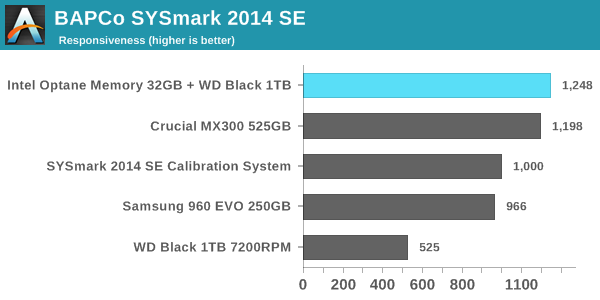
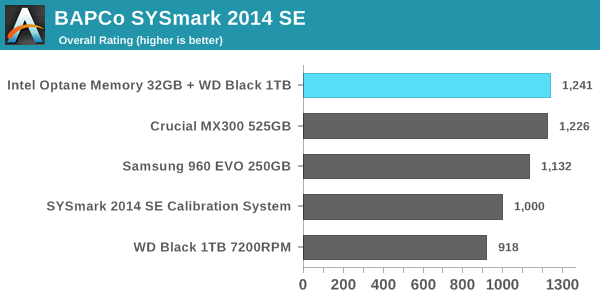
In every performance category the Optane caching setup is either in first place or a close tie for first. The Crucial MX300 is tied with the Optane configuration for every sub-test except the responsiveness test, where it falls slightly behind. The Samsung 960 EVO 250GB struggles, partly because its low capacity and the low degree of parallelism that implies means it often cannot take advantage of the performance offered by its PCIe 3.0 x4 interface. The use of Microsoft's built-in NVMe driver instead of Samsung's may also be holding it back. As expected, the WD Black hard drive scores substantially worse than our solid-state configurations on every test, with the biggest disparity occurring in the responsiveness test: The WD Black hard drive will force users to spend more than twice as much time waiting on their computer than if it has a SSD.
Energy Usage
SYSmark 2014 SE also adds energy measurement to the mix. A high score in the SYSmark benchmarks might be nice to have, but, potential customers also need to determine the balance between power consumption and the efficiency of the system. For example, in the average office scenario, it might not be worth purchasing a noisy and power-hungry PC just because it ends up with a 2000 score in the SYSmark 2014 SE benchmarks. In order to provide a balanced perspective, SYSmark 2014 SE also allows vendors and decision makers to track the energy consumption during each workload. In the graphs below, we find the total energy consumed by the PC under test for a single iteration of each SYSmark 2014 SE workload and how it compares against the calibration systems.
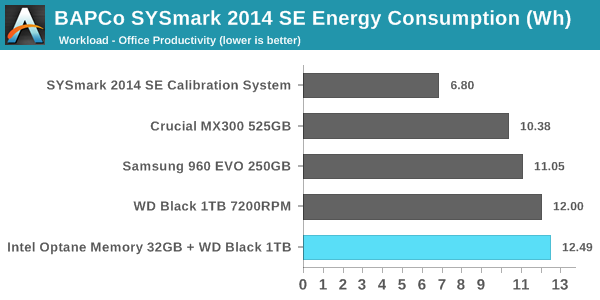
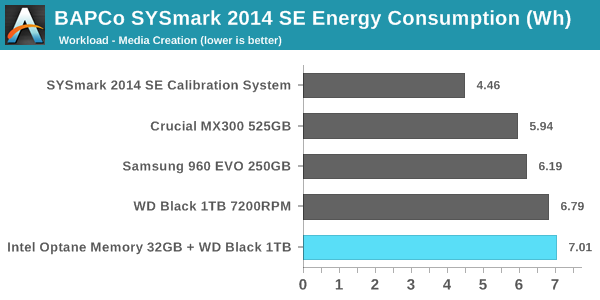
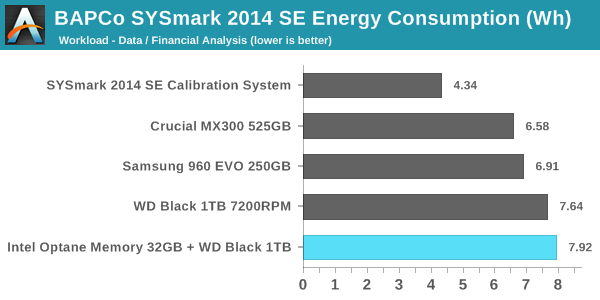
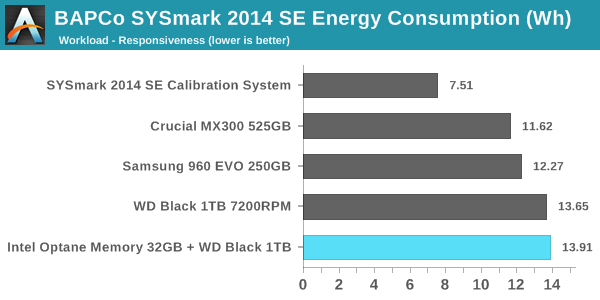
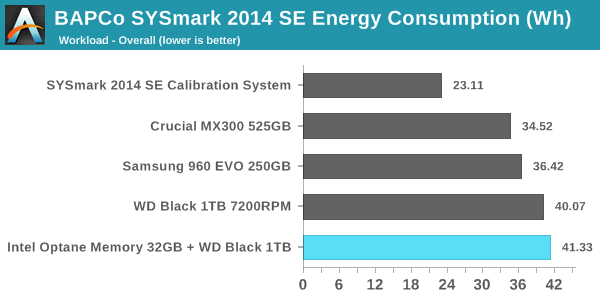
The peak power consumption of a PCIe SSD under load can exceed the power draw of a hard drive, but over the course of a fixed workload hard drives will always be less power efficient. SSDs almost always complete the data transfer sooner, and they can enter and leave their low-power idle states far quicker. On a benchmark like SYSmark, there are no idle times long enough for a hard drive to spin down and save power.
With an idle power of 1W, the Optane cache module substantially increases the already high power consumption of the hard drive-based configurations. It does allow for the tests to complete sooner, but since the Optane module does nothing to accelerate the compute-bound portions of SYSmark, the total time saved is not enough to make up the difference. It also appears that the Optane caching is not being used to enable more aggressive power saving on the hard drive—Intel's probably flushing writes from the cache often enough to keep the hard drive spinning the whole time. What this adds up to is a difference that's quite clear but not big enough for desktop users to be too concerned with unless their electricity prices are high. The Optane Memory caching configuration is the most power-hungry option we tested, while the second-place performing Crucial MX300 configuration was most efficient, using about 16% less energy overall.
For mobile users, the power consumption of the Optane plus hard drive configuration is pretty much a deal-breaker. Our Optane review system is not optimized for power consumption the way a notebook system would be, so for a mobile user the Optane module would account for an even larger portion of the total battery draw, and battery life will take a serious hit.










110 Comments
View All Comments
ddriver - Wednesday, April 26, 2017 - link
It is only natural to have negative sentiments about greedy, lousy corporations because of what they do. It is nothing personal though, I do it because I am a conscious human being. Not cattle. You can throw crapple and moogle into the mix. There is no single good reason to be fond of any corporation. The bigger they are the more damage they do to humanity and the planet as a whole.In other news, water is wet!
eddman - Wednesday, April 26, 2017 - link
You are not fooling anyone.eddman - Wednesday, April 26, 2017 - link
...and you are so blind by your hatred that you dismiss every single thing that these companies do. You are not rational in the slightest but do like to boast about how great you are.Reflex - Tuesday, April 25, 2017 - link
Nailed it eddman. Because it does not personally solve ddriver's problems, or because it comes from the wrong brand, its an epic disaster. The funny thing here is I agree this is not a revolution, at least not yet, but the incessant bashing and inability to acknowledge that it has its uses and those use cases are likely to only grow demonstrates the bias involved.Reflex - Tuesday, April 25, 2017 - link
To the insinuation that Optane may somehow be relabeled SLC NAND, I went and did a little research/consultation. All NAND requires writing to blocks, Optane can support bit level writes (expected in DIMM configurations), which is a major advantage over NAND and not technically possible with NAND. It was also pointed out that if Optane was simply disguised SLC, despite the technical impossibility, it would mean that Intel had engaged in financial fraud by materially misrepresenting its technology, capabilities and long-term expectations to investors.Thanks to Joel Hruska for looking into it for me.
More info here: https://arstechnica.com/gadgets/2017/04/intel-opta...
More from Joel here: https://www.extremetech.com/author/jhruska
Reflex - Monday, April 24, 2017 - link
OMG it's the fastest product on the market in its class but because I choose to interpret the early marketing as applying to the first gen product it totally sucks! I refuse to benefit from drastically better performance because Intel *dared* to speak to its potential performance and didn't deliver that in the first product!In fact, I am so enraged I'm ripping out all my existing SSD's and replacing them with Quantum Bigfoot drives in protest.
Drumsticks - Monday, April 24, 2017 - link
It's probably because Intel dared to do something innovative again, and we can't possibly give credit where it's due, can we? If it was Samsung, I bet it would just be Samsung being Samsung. Slap the blue name on top, and it's cool to criticize whatever you can, even in the face of hard numbers. Make sure you also include an edgy name like "Hypetane" to really drive your point home.Reflex - Monday, April 24, 2017 - link
To be fair if it were Samsung we'd get a lecture on the oppression of North Korea mixed in there somewhere along with a conspiracy theory about the south being a puppet state not permitted to succeed in the face of America.jabbadap - Monday, April 24, 2017 - link
Well I don't want to degrade intel's efforts on this. But it's intel/micron co-operation who have engineered this and I would even guess a bit further that science behind this is more micron tech than intels.Drumsticks - Monday, April 24, 2017 - link
That's fair, and Micron definitely deserves credit as well. I'm sure they'll get their own when QuantX comes out, hopefully sometime this year. I suspect that the R&D was split very evenly, though; Intel has always been good at doing things "well" in the fab; Micron had excelled at doing them "cheaply" which is one reason the venture was reasonably successful. Plus, I feel it would be hard to collaborate on R&D together for 10 years and successfully say "we did this together" to the public, if one side (Micron or Intel) did most of the work. I guess we'll never know, though.